Moved Permanently
The document has moved here.
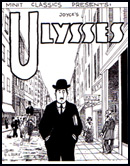
Growing up I loved cartoons. I loved to read them and draw them. Strips and panels. Bloom County, Doonesbury, The Far Side. Editorial cartoons. I could not stand comic books. Super heroes, monsters, ridiculous teenagers. None of this held any appeal for me.
When I met David Lasky, he introduced me to comics the likes of which I had never seen. These comics tackled social injustice, politics, history, and (ahem) adult themes. David's own comics followed his own interests. He drew biographical works on James Joyce and John Lee Hooker (a sample of which can be seen here). He drew a (very) miniature version of James Joyce's Ulysses.
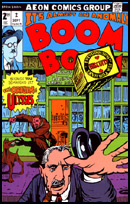
After leaving college, he went to Seattle and found a circle of young comic book artists drawing and publishing their own work. In 1993, David won a grant from the Xeric Foundation (established by Peter A. Laird, co–creator of the Teenage Mutant Ninja Turtles) to self–publish his comic "Boom Boom." With this nudge, "Boom Boom" left its "mini–comic" format, put on a color cover and began to take on its mature form as part history, part graphic novel, part surreal cartography. David choose the comic layout of Jack Kirby (creator of the Hulk, the Fantastic Four and Captain America) for the James Joyce biography in Boom Boom #2. Throughout the 90s, Pulse magazine (a publication of Tower Records) published a series of David's comic biographies and musical impressions (a sample appears on his website). These full page cartoons are a collage of image, text and story that stretches the limits of comic art and becomes a kind of visual essay. Those featured included Beethoven, Bob Dylan and legendary saxophonist Lester "Pres" Young. David's contribution to the comic anthology "Two–Fisted Science" chronicles the life of physicist Richard Feynman during his time with the Manhattan Project at the Los Alamos National Lab.
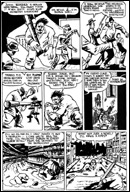
David continues to push the boundaries of traditional comics in his recent collaboration with humorist Greg Stump called "Urban Hipster" (published by Alternative Comics) which was nominated in 1999 for the Harvey Award for best new series. A sample of David's minimalist adaptation of Edgar Allen Poe's "The Raven" can be found here.
The one thing I have learned to expect from each of David Lasky's new projects is to expect the unexpected. Nothing is like anything that came before it. From all indications, we have a lot to look forward to.
The David Lasky Interview
1. When I first became involved with the IAF and their mission of identifying artists who "cross borders" was made clear to me, I immediately thought of the Yahoo! discussion group you ran for years called "Comics as Fine Art." What was your inspiration for starting this discussion?
It was actually started by a brilliant man named Benjamin Godfrey, who made some little known but intricately clever mini comics in the 90's. Benjamin's idea was to talk about comics as a Fine Art. Since at least the late 1960's, certain artists have been creating comics as serious artists, so it only made sense to discuss the medium as a legit art form. We had some great discussions until September 11th 2001. Our discussion on Yahoo came to a halt at that point and has never really picked up since.
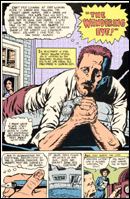
2. Many of your works not only "cross the border" between art and comics, but your adaptations of novels (James Joyce's Ulysses) and your biographical comic works (Joyce, Beethoven, John Lee Hooker) traverse many boundaries of genre and category. How have these works been received by the different groups you have presented them to?
The Joyceans have responded enthusiastically, which was a surprise to me at first. But when you think about it, James Joyce was one of the first and one of the best writers to hijack different genres for his own ends. I think the fact that I approach my subject (no matter what it is) with all the integrity I can muster has helped me with Joyce scholars. If I were approaching the material casually, it would be easier to dismiss what I'm doing.
Music related comics received much less feedback — though I've just released the first chapter in a series about The Carter Family of country music (in collaboration with writer/colorist Frank Young) that is being very well received by fans of old time music.
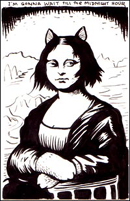
3. Separate from the response of people seeing your works, how have you decided to market these works? Has it been difficult to find a niche or convince potential sellers of the interest the work might generate?
Marketing is not my strong suit. If I'd known more about marketing, I may never have made any of my most interesting comic books. I'm fortunate in that I've been hooked up with publishers, like my first publisher, Edd Vick, who believes in what I'm doing enough to give me a large degree of freedom. The downside of this is that I very rarely am paid for any of the comics I create. If I can't interest a publisher, I self–publish. Advances in photocopy technology have made it possible to release some pretty good looking publications if you know what you're doing. In fact it was you, Kendrick, who showed me what a good photocopier was capable of back around 1987. You were planting the seed that would become a large crop of self–published booklets.
4. I know that your Ulysses mini–comic was reviewed by The Washington Post of all places. Can you tell us how that came to pass?
I created the comic in 1990, and put a lot of work into it. I mailed it out to a few cartoonists and got lukewarm responses. As a lark, I mailed one to the Post's Bookworld section, which I had grown up reading. I was completely stunned when a reporter phoned me for an interview a few weeks later. The resulting few paragraphs generated hundreds of orders and the mini comic sells to this day (now on Ebay). It was a good learning experience for me — to never underestimate myself or my nutty ideas.
5. During your college days, you produced a magnificent series of sandwich paintings, doing watercolor portraits of your lunch before eating it. (And despite the scope and number of the portraits, I was never able to get my hands on one, as they all ended up promised to the artist's models in the art department.) These works certainly showed both the influence of comics and more formal studio technique (and might just cross the line between the culinary and visual arts!). In addition to your comics, have you been working on any other compositions lately?
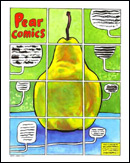
I just want to point out that sandwich–making is an art all its own. I had a job in the college deli that year, and had to expand my definition of "art" as a result. Some of those sandwiches I made had a structural and aesthetic beauty that's hard to put into words.
I've been writing poems in my free time, and also painting pears. Pears were a favorite subject in college which I rediscovered a few years ago. What can I say about pears? They're beautifully shaped and they taste good. The new thing that I began in my recent pear paintings is to transform the still life into a comics page (or vice versa). These are maybe my least understood creative works. But they have their audience.
6. What influences, comic and otherwise have informed your style? Have you ever felt pressure from an instructor (or other force of the market or category) to include or exclude specific elements of style or influence?
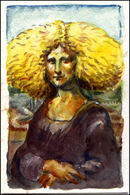
There are restrictive paradigms all around, in the academic world, the commercial world, and even (or perhaps I should say "most of all") in the world of aesthetics. College art professors didn't understand my interest in comic books. Comic artist peers don't always understand my need to write poetry. Most people don't "get" pear–comics. It's something I've always struggled against. I think the struggle is what attracts me. In my teens I was very inspired by what Jimi Hendrix did with an electric guitar. I try to approach words and images the way he approached sound and music.
7. What artists working today do you believe "cross borders" in interesting ways? (Be bold, we might just call them and ask them to be the next featured artist!)
When I first arrived in Seattle in the early 90's, I fell in with a great crowd of peers. It was a very good time and place for me to be. Artists like Jon Lewis, Megan Kelso, Tom Hart, Ed Brubaker, and Jason Lutes were beginning to take cliched or neglected genres of comics and revitalize them with the lessons learned from the first wave of alternative comics.
Today there are a lot of comic book artists who do unexpected things with the medium. Here are a few:
- Joe Sacco (comics as journalism)
- Sammy Harkham (the "Kramers Ergot" anthology)
- Dan Clowes
- Souther Salazar

